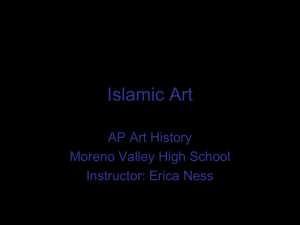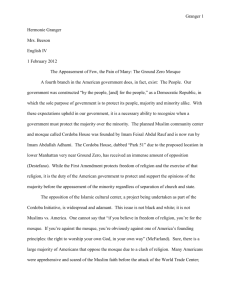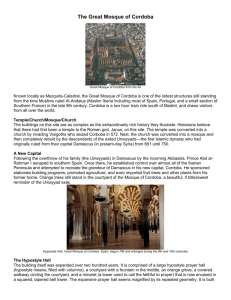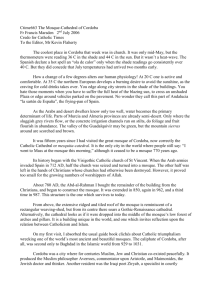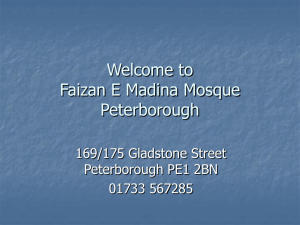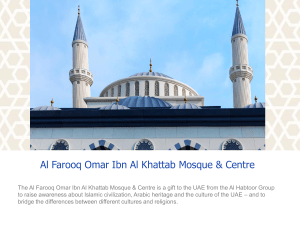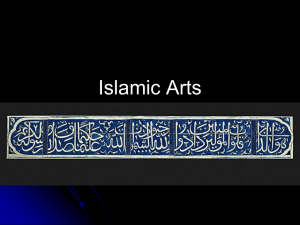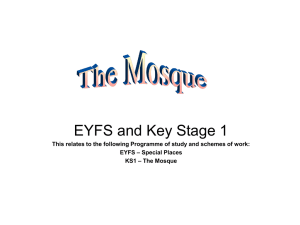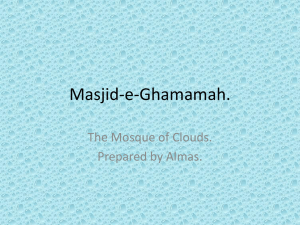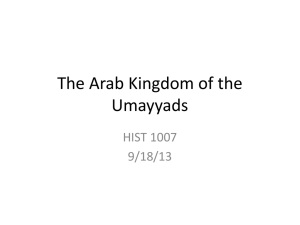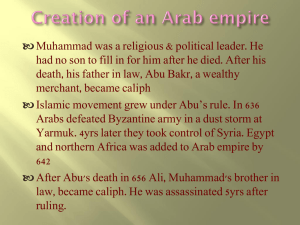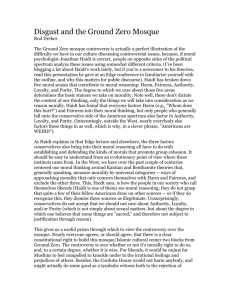AP_Art_History-Chapter_13
advertisement
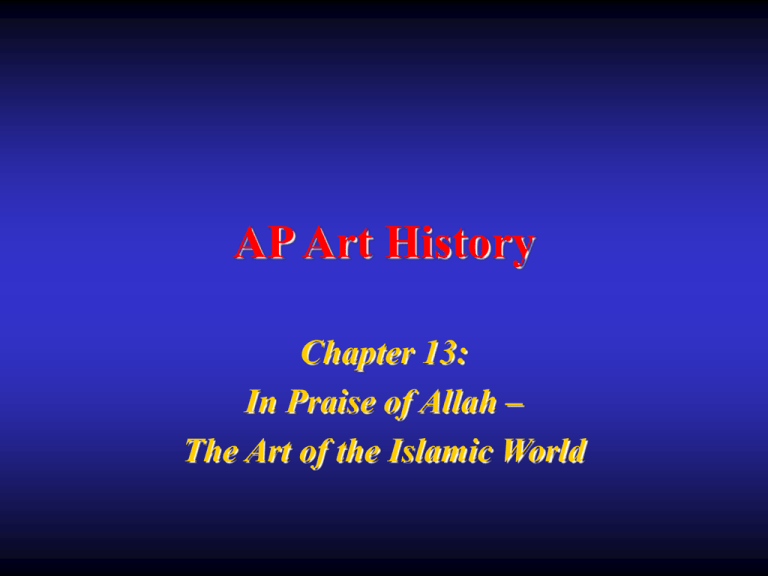
AP Art History Chapter 13: In Praise of Allah – The Art of the Islamic World Chronology: 570-1600 570-700 Birth of Muhammad: ca. 570 Muhammad’s 1st revelation: 610 Muhammad’s flight to Medina (Hijra): 622 Death of Muhammad in Median: 632 Muslims capture Jerusalem: 638 Muslim conquest of Lower Egypt: 642 Umayyad Caliphate established: 661 700-800 Muslim armies enter Spain: 711 Charles Martel defeats Muslims at Poitiers: 732 Abbasid Caliphate established: 750 Umayyad Caliphate established in Spain: 756 Abbasids found Baghdad: 762 800-900 1000-1100 Fall of Umayyad Caliphate in Spain:1031 Seljuk Dynasty estab. In Iran: 1038 First Crusade Captures Jerusalem: 1099 1100-1200 Saladin founds Ayyubid Dynasty in Egypt: 1171 Saladin captures Jerusalem from Crusaders: 1187 1200-1300 Sultanate of Delhi estab. 1206 Nasrid Dynasty estab. At Granada: 1230 Mamluk Dynasty estab. In Egypt: 1250 Mongols sack Baghdad: 1258 Ottoman Empire founded: 1281 1300-1500 Ottomans capture Constantinople: 1453 Fall of Granada to the Christians: 1492 Samanid Dynasty estab. in Transoxiana: 819 1500-1600 900-1000 Safavid Dynasty estab. In Iran: 1501 Mughal Dynasty estab. In India: 1526 Ottomans Capture Baghdad: 1534 Fatimid Dynasty established in Egypt: 909 Fatimids found Cairo: 969 The Islamic World Dome of the Rock, Jerusalem 687-692 Detail of Dome of the Rock, Interior Aerial view of the Great Mosque, Damascus, Syria 706-715 Detail of a mosaic in the Courtyard arcade of the Great Mosque, Damascus Plan of the Umayyad palace, Mshatta, Jordan, ca. 740-750 Aerial view of the Great Mosque, Kairouan, Tunisia, ca. 836-873 Plan of the Great Mosque, Kairouan, Tunisia Malwiya minaret of the Great Mosque, Samarra, Iraq, 848-852 Mausoleum of the Samanids, Bukhara, Ubekistan early 10th century Alternate view Prayer hall of the Great Mosque, Cordoba, Spain, 8th to 10th centuries Exterior View Maqsura of the Great Mosque, Cordoba, Spain, 961-965 Dome in the front of the mihrab Of the Great Mosque, Cordoba, Spain, 961-965 Confronting lions and palm tree, fragment of textile near Bukhara, Ubekistan, 8th century Sulayman, Ewer in the form of a bird, 796 Koran page with beginning of surah 18, al-Kahif (The Cave) 9th or early 10th century Muqarnas dome, Hall of the Two Sisters, Alhambra palace, Granada, Spain, 1354-1391 Madrasa-mosque-mausoleum complex of Sultan Hassan Cairo, Egypt, begun 1356 Mihrab of the Sanctuary Liwan (interior) of Sultan Hassan Mosque Sinan, Mosque of Selim II, Edirne, Turkey, 1568-1575 Sinan, interior of the Mosque of Selim II Aerial view of the Great Mosque, Isfahan, Iran 11th to 17th centuries Detail Winter prayer hall of the Shahi (Imam) Mosque, Isfahan, Iran, 1611-1638 Mihrab from the Madrasa Imami, Isfahan, Iran, ca. 1354 Maqsud of Kashan, Carpet from the funerary mosque of Shaykh ali-Din, Ardabil, Iran, 1540 Muhammad Ibn ali-Zayn, basin from Egypt, ca. 1300 Canteen with episodes of the life of Christ, From Syria, ca. 1240-1250 Comparison Section Study the reproductions of the following buildings: Hagia Sophia (Figs. 12-3 to 12-5), The Mosque of Cordoba (Figs. 13-11 to 13-13), and the Pantheon (Fig. 10-48). Compare The lighting effects created by each and describe the means used to achieve such effects. Hagia Sophia (alt. view) Mosque of Cordoba (13-11) Pantheon (alt. view) Compare the treatment of the figures on the Islamic basin shown in Fig. 13-29 with the Roman horseman shown in the Roman relief (Fig. 10-58), the Roman Sarcophagus (Fig. 10-71), and the Byzantine Barberini ivory (Fig. 12-1). What compositional devices does each artist use and how does each organize multiple figures and depict them? Which do you like best? Why? Roman horsemen (Fig. 10-58) Islamic basin (Fig. 13-29) Roman Sarcophagus (Fig. 10-58) Barberini Ivory (Fig. 12-1)
